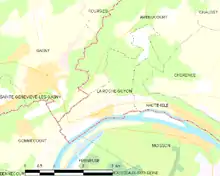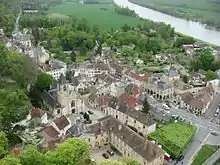La Roche-Guyon
La Roche-Guyon (French pronunciation: [la ʁɔʃ.gɥi.jɔ̃] (![]() listen)) is a commune in the Val-d'Oise department in Île-de-France in northern France. It is located in the Vexin regional nature park.
listen)) is a commune in the Val-d'Oise department in Île-de-France in northern France. It is located in the Vexin regional nature park.
La Roche-Guyon | |
|---|---|
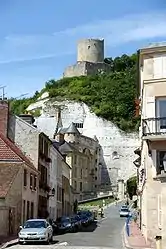 La Roche-Guyon, the castle and the keep | |
.svg.png.webp) Coat of arms | |
Location of La Roche-Guyon 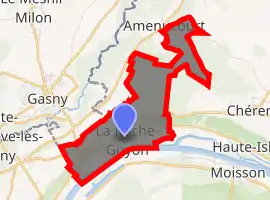
| |
 La Roche-Guyon 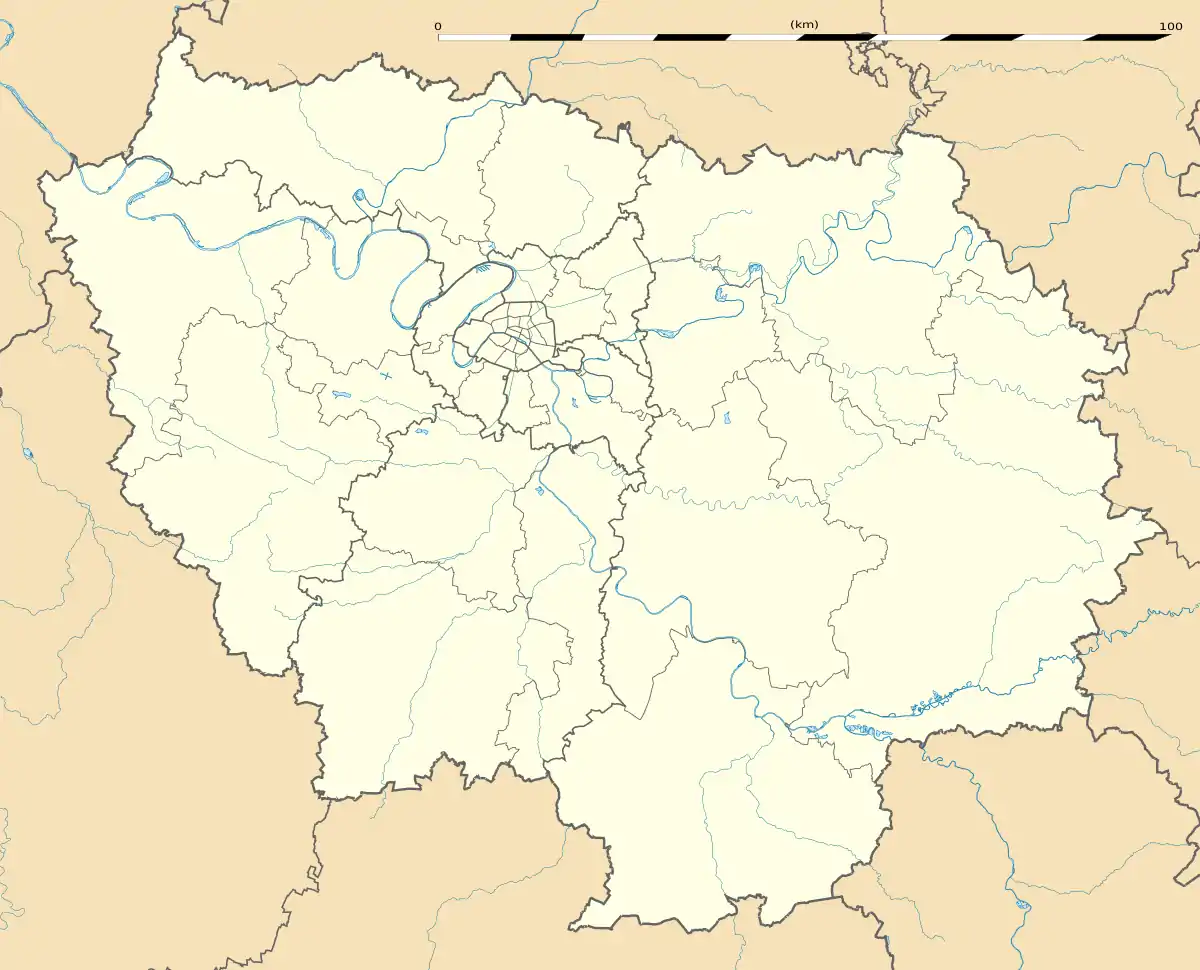 La Roche-Guyon | |
| Coordinates: 49°04′56″N 1°37′49″E | |
| Country | France |
| Region | Île-de-France |
| Department | Val-d'Oise |
| Arrondissement | Pontoise |
| Canton | Vauréal |
| Intercommunality | Vexin Val de Seine |
| Government | |
| • Mayor (2020–2026) | Capucine Faivre[1] |
| Area 1 | 4.61 km2 (1.78 sq mi) |
| Population (2017-01-01)[2] | 478 |
| • Density | 100/km2 (270/sq mi) |
| Time zone | UTC+01:00 (CET) |
| • Summer (DST) | UTC+02:00 (CEST) |
| INSEE/Postal code | 95523 /95780 |
| Elevation | 13–143 m (43–469 ft) |
| 1 French Land Register data, which excludes lakes, ponds, glaciers > 1 km2 (0.386 sq mi or 247 acres) and river estuaries. | |
The commune grew around the Château de La Roche-Guyon, upon which historically it depended for its existence. The commune's population in 2015 was 464.
Château de La Roche-Guyon
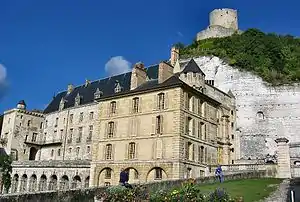
The present Château de La Roche-Guyon[3] was built in the 12th century, controlling a river crossing of the Seine, itself one of the routes to and from Normandy;[4] The Abbé Suger described its grim aspect: "At the summit of a steep promontory, dominating the bank of the great river Seine, rises a frightful castle without title to nobility, called La Roche. Invisible on the surface, it is hollowed out of a high cliff. The able hand of the builder has established in the mountainside, digging into the rock, an ample dwelling provided with a few miserable openings".[5] In the mid-13th century, a fortified manor house (the château-bas) was added below. Guy de La Roche fell at the Battle of Agincourt, and his widow was ousted from the Roche, after six months of siege, in 1419; she preferred to depart rather than accept Henry Plantagenet as her overlord.
James V of Scotland and his bride Madeleine of Valois stayed for two nights in March 1537.[6] The Château came to the Liancourt family with the marriage of Roger de Plessis-Liancourt to the heiress Marie de La Roche; he was a childhood companion of Louis XIII, first gentleman of the Chambre du Roi, and was made a duke in 1643. He and his wife made great changes to the château-bas, opening windows in its structure and laying out the terrace to the east, partly cut into the mountain's steep slope.
The domain of La Roche-Guyon came to the La Rochefoucauld family in 1669, with the marriage of Jeanne-Charlotte de Plessis-Liancourt with François VII de La Rochefoucauld. The Château retained its medieval aspect of a fortress, with its moat and towers and cramped, dark living apartments. The Château was largely extended in the 18th century.
When Turgot, the minister of Louis XVI, failed in his schemes for fundamental reforms in 1776, he retired to the Château briefly, as the guest of Louise Elisabeth Nicole de La Rochefoucauld, Duchesse d'Enville.
La Roche Guyon was the birthplace of François Alexandre Frédéric, duc de la Rochefoucauld-Liancourt (1747–1827).
The castle was used as a setting for the medieval segment of a famous Franco-Belgian graphic novel on time travel: Le Piège diabolique (The Diabolical Trap) of the Blake and Mortimer series by Edgar Pierre Jacobs.
After D-Day, German Field Marshal Erwin Rommel (1891–1944) defended Normandy against the Allies in World War II from a bunker located here. The castle also was Rommel's headquarters.
Restorations and archaeological surveys undertaken after 1990 by the Conservatoire régional des Monuments historiques revealed new additions to the documentary history of La Roche-Guyon, undertaken in the 19th century by Hippolyte Alexandre and Emile Rousse.
At the beginning of 1960, French technocrats had the idea for a new administrative capital, to replace Paris as capital with a French "Brasilia" built near La Roche-Guyon and to transform the commune into a "Monaco on the Seine". At the beginning of 1960 there was an architectural design competition for the Project, in which the architects Albert Laprade and Jean Brasilier participated.
The castle is now open to the public.
References
- "Répertoire national des élus: les maires". data.gouv.fr, Plateforme ouverte des données publiques françaises (in French). 2 December 2020. Retrieved 7 December 2020.
- "Populations légales 2017". INSEE. Retrieved 6 January 2020.
- Its early seigneurs, vassals of the comtes de Meulan, traditionally bore the name Guy; La Roche-Guyon signifies the "Rock of Guy"
- A 9th-century document leads historians to believe that the site was already fortified as part of the defences against Viking marauders who used the Seine as a pathway upriver to Paris (Le Ménestrel du Vexin).
- Suger, Vie de Louis VI, "Au sommet d'un promontoire abrupt, dominant la rive du grand fleuve de Seine, se dresse un château affreux et sans noblesse appelé La Roche. Invisible à sa surface, il se trouve creusé dans une haute roche. L'habile main du constructeur a ménagé sur le penchant de la montagne, en taillant dans la roche, une ample demeure pourvue d'ouvertures rares et misérables."
- James Balfour Paul, Accounts of the Treasurer of Scotland, vol. 7 (Edinburgh, 1907), p. 19.
External links
| Wikimedia Commons has media related to La Roche-Guyon. |
- Official website (in French)
- Château de la Roche-Guyon: Official website (in French)
- Base Mérimée: Search for heritage in the commune, Ministère français de la Culture. (in French)
- Association of Mayors of the Val d’Oise (in French)
- " La duchesse d'Enville à la Roche-Guyon"
- History of the castle of the Roche Guyon (French)
- INSEE commune file
